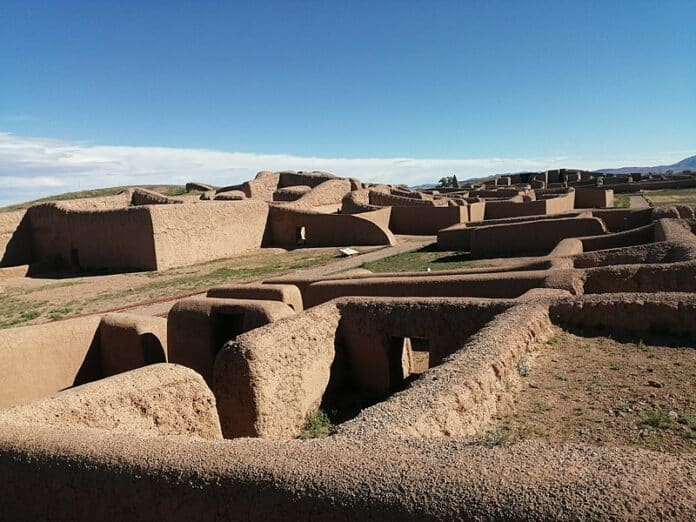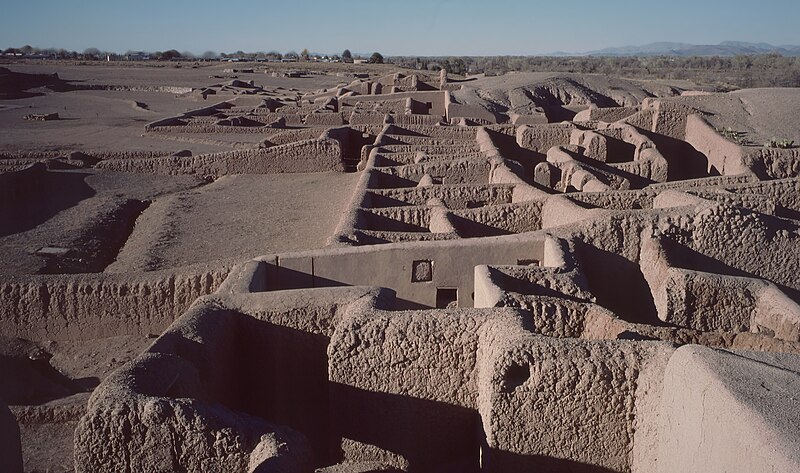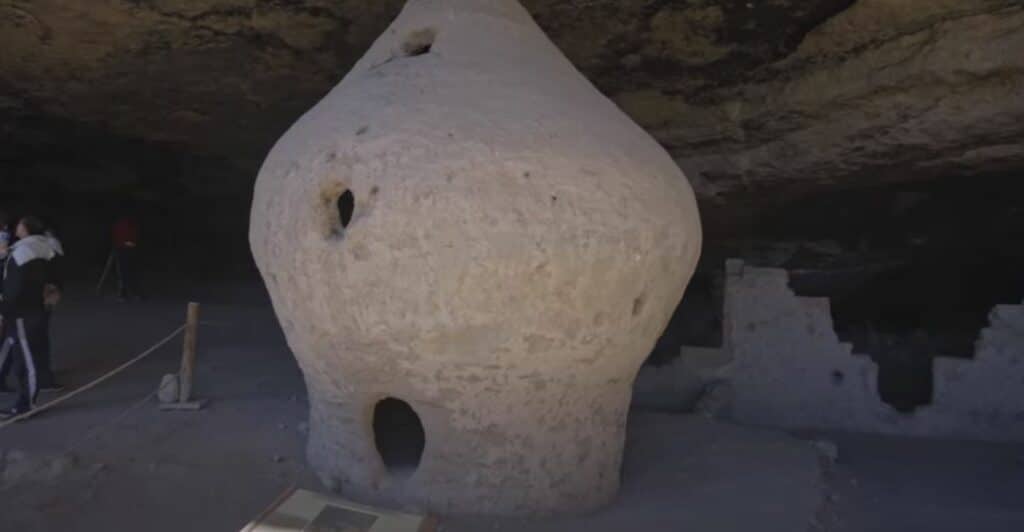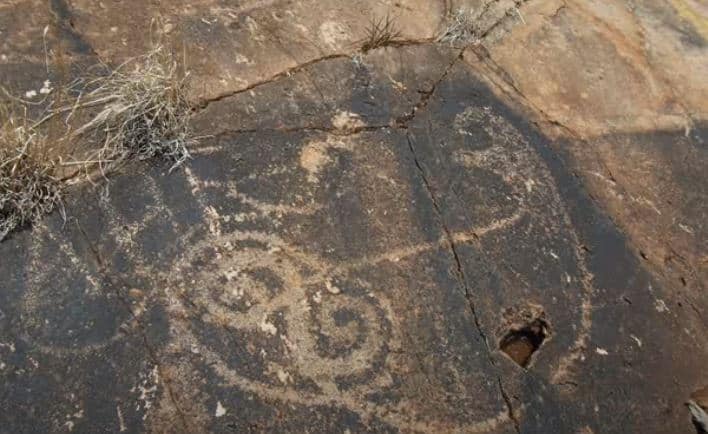Casas Grandes, Chihuahua is located in the heart of the state of Chihuahua, in northern Mexico. Known for its rich history, breathtaking landscapes, and friendly people, this tourist destination is a hidden gem worth discovering.
These pre-Columbian structures, also known as Paquimé, are considered a UNESCO World Heritage Site and bear witness to the ancient indigenous culture that inhabited the region. These imposing constructions are a true archaeological treasure and offer a fascinating insight into the history of this area.
This charming town, whose name in the Tarahumara or Rarámuri language means “Place of large houses,” stands as a living testament to the history and culture that have shaped the region over the centuries. Casas Grandes has been named a Pueblo Mágico (Magic Town) since 2015, giving it added value as a tourist destination.
Located just three kilometers from the city of Nuevo Casas Grandes and surrounded by the enigmatic archaeological zone of Paquimé, this locality blends ancestral tradition with contemporaneity in a symphony of unique experiences.
Explore the treasures that the old town of Casas Grandes has to offer, from its historic sites to its vibrant cultural manifestations and the warm hospitality of its people. Dive with us into the heart of Casas Grandes and discover the magic that makes it an unforgettable destination in northern Mexico.
Discover the wonderful Casas Grandes, Chihuahua, and travel to Mexico with us.
Download FREE!
Copper Canyon Travel Guide
🚂 Discover the enchanting beauty of the Copper Canyon tour and the thrilling Chepe Train with our FREE ebook!
🌄 Enter your name and email below to receive our FREE ebook and immerse yourself in breathtaking landscapes, vibrant cultures, and unforgettable experiences.
*By clicking send, you agree to receive information about products, services, promotions, or recommendations via email.
The Origin of Casas Grandes, Chihuahua
Lo que vas a ver en este artículo
The history of Casas Grandes, located in Chihuahua, Mexico, is rich and varied. It is believed that the region was a settlement of the Nahua Indians during their migration from northern America to central Mexico in search of better living conditions. It is important to note that although the Aztecs were Nahua, not all Nahua were Aztecs. It is said that there are still some ruins near the municipal seat dating back to the Nahua’s stay in the area.
In addition to the Nahua, the region of Casas Grandes, Chihuahua, was also inhabited by Jova and Apache Indians, contributing to the cultural diversity of the area.
In the 18th century, the town of Casas Grandes became the first and most important center of authority in the region, with the rank of Alcaldía Mayor. Over time, the population became subordinate to the presidio of San Buenaventura, reflecting the strategic importance of the region during that period.
Around 1820, the region of Casas Grandes acquired the status of municipality, a status it has maintained to this day. This marked a milestone in the history of the locality, as it became an autonomous political entity within the state of Chihuahua.
Throughout the years, Casas Grandes, Chihuahua has experienced significant changes in its economic, social, and cultural development, but its history as a meeting point for different indigenous groups and its importance as a municipality have left a lasting mark on the region’s identity.
5 Popular Attractions in Casas Grandes: What to See
This picturesque region offers a wide variety of attractions that will captivate any visitor. From archaeological sites to natural beauties, there is something for everyone. Below, we’ll explore some of the must-see attractions in Casas Grandes, Chihuahua:
1. Exploring the Cave of the Olla
The Cave of the Olla, in Casas Grandes, Chihuahua, is an archaeological treasure that holds the secrets of ancient civilizations that inhabited this region. This site is sheltered by rocks and time in the natural shelter of a cave. Its name evokes images of mystery and wonder, as it features a rounded structure resembling a giant pot.
Inside this “pot” is a cuexomate or granary of impressive dimensions, whose shape reminds us of an immense ancestral vessel. Similar granaries have been found scattered in various caves of the majestic Sierra Madre Occidental. But what truly makes the Cave of the Olla fascinating is its history of occupation that spans millennia.
In this place, ancient human groups settled thousands of years ago, around 5500 B.C., and used an ancestral variety of corn for their subsistence. The need to face the rigors of the harsh winter led to the construction of this granary, which still stands, although marked by the passage of time and history.
Visiting the Cave of the Olla is a journey through time to the roots of humanity in Casas Grandes, Chihuahua. To get there, one must take the road from Casas Grandes, Chihuahua, towards Colonia Juárez, continuing to the ejido Ignacio Zaragoza. This dirt road, with stretches of a single lane, leads us to a unique archaeological treasure.
Upon reaching the ejido, we travel two kilometers to Rancho Casa Blanca, and then advance one more kilometer to reach the archaeological zone. This site is one of the oldest in the state of Chihuahua and throughout the Mexican Republic, and is located just 400 meters from the equally impressive Cave of the Swallow.
Both places speak of the ancient traces left by our ancestors on this land, a lasting testimony to the historical and cultural richness of the region.
2. Juan Mata Ortiz: A Hidden Treasure
Juan Mata Ortiz, a small town in Casas Grandes, Chihuahua, emerges as a cultural and artistic treasure amidst the natural beauty of the region.
The town’s name pays tribute to Juan Mata Ortiz, a brave Chihuahuan soldier from the 19th century who distinguished himself in the fight against the Apache tribes inhabiting the region.
However, what truly distinguishes Juan Mata Ortiz is its rich ceramic tradition. The inhabitants of this town have developed exceptional skills for creating high-quality ceramics. Its artisans have revived ancient pottery techniques dating back to the pre-Hispanic cultures of the region and have merged these techniques with their own creativity and artistic vision.
The result is a ceramic unique in its kind, known for its delicacy, beauty, and sophistication. Each piece is a work of art in itself, with intricate designs, vibrant colors, and craftsmanship that reflects the passion and skill of local artists. The ceramists of Juan Mata Ortiz have managed to transcend the borders of Mexico, and their ceramics are exhibited in galleries and museums around the world.
3. The Mystery of the Paquimé Ruins
Paquimé, an archaeological treasure located in Casas Grandes, Chihuahua, is a fascinating testimony to the ancient Culture of Paquimé, a legacy that endures over time and in the memory of humanity.
This archaeological site, declared a UNESCO World Heritage Site in 1998, is a living reminder of an ancient civilization that flourished in this region centuries ago. Paquimé is a silent witness to the greatness of a culture that built intricate structures, created exquisite pottery, and developed a complex society in harmony with its environment.
The heart of Paquimé is formed by its imposing structures, which stand as monuments to human engineering and creativity. Its buildings, designed with precision and built with skill, tell the story of a community that thrived here. The pottery found at this site is an artistic marvel, with designs and techniques that reflect the skill and vision of its artisans.
But Paquimé is more than just stone and ceramic; it is a tangible link to the past, a portal that transports us to a time when the native cultures of this region connected and traded with other distant civilizations. The trade routes that crossed this land were a meeting point for cultural and economic exchange.
The landscape surrounding Paquimé is equally impressive. The aridity of the desert and the beauty of the Sierra Madre Occidental provide the perfect backdrop for this ancient enclave. Nature and history intertwine in this land, creating a unique experience for those who visit.
If you want more information about Mexico, we invite you to read the following article: Exploring the Natural Beauty of the Sierra Taraumara: A Must-Visit Destination in Mexico.
4. Museum of Northern Cultures
The Museum of Northern Cultures, a true cultural treasure, is much more than just a building; it is a masterpiece of architecture in Casas Grandes, Chihuahua, that pays tribute to the rich heritage of the region.
Conceived by the talented architect Mario Schjetnan and opened to the public on February 26, 1996, this museum is a jewel that stands in the landscape as a monument to the past and present of the cultures of northern Mexico.
The museum’s design is a tribute to the ceremonial mound of Paquimé, an ancestral structure that guards ancient secrets. The circular floor plan of the museum evokes the essence of the culture that inspires it, while its spacious interior courtyards and extensive windows open to the desert landscape that surrounds it, connecting art and architecture with nature.
The Museum of Northern Cultures is not only a visual testament to the greatness of Paquimé’s culture, but also a recognition of the contemporaneity and creativity that are still alive in the region. Its design, with tones and textures that integrate harmoniously with the desert environment, is a testament to how art and architecture can dialogue with nature and history.
The Museum of Northern Cultures is a place where history and modernity merge into a unique experience. It is a tribute to the cultural heritage of the region and a testament to how architecture can be an artistic manifestation that celebrates the past and present of a community. Visiting this museum is immersing oneself in a world of creativity and contemplation, where architecture and culture embrace in an eternal hug.
If you want to know more information visit the official page of the Museum of Northern Cultures.
5. Arroyo de los Monos
Arroyo de los Monos, an enigmatic archaeological treasure located in the ancestral lands of Casas Grandes, Chihuahua, stands as a unique testimony to Mexico’s rich cultural heritage. This site, though little known, harbors an invaluable legacy that blends landscapes of breathtaking beauty with unparalleled archaeological wealth.
Nestled in the majesty of the region, this historic corner reveals rock engravings dating back to the Mogollon and Ocán cultures. These artistic manifestations on the rocks unfold like an ancient canvas that transports us to a past where human figures, magnificent animals, and hunting scenes were the expression of a civilization in harmony with its environment.
Arroyo de los Monos is more than a place of archaeological mystery; it is a testimony to the artistic ability and cultural complexity of the ancient inhabitants of this region. Each petroglyph represents a window to the past, a link to the roots of our history that transcends time and connects us to the origins of our Mexican identity.
Conclusion
Casas Grandes, Chihuahua, is a place of profound historical, cultural, and natural richness in northern Mexico. From its mysterious archaeological structures, such as those of Paquimé, to the warmth of its people and the beauty of its desert landscape, this region holds treasures that deserve to be explored and valued.
The history of Casas Grandes is a testament to human creativity and adaptation to the environment, while its cultural heritage continues to enrich the diversity of Mexico. As this area evolves and develops, it is essential to preserve and share its legacy for future generations, so they can continue to marvel at the greatness of Casas Grandes, Chihuahua.
If you want more information about Mexico, we invite you to read the following article: Discovering Creel Magical Town: Between Ancestral Traditions and Natural Beauty.





















